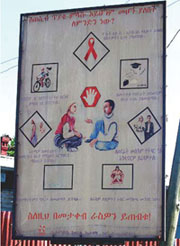20.5.1 Transmission through sexual relations
Unsafe sex (sexual intercourse without a condom) is responsible for the majority of HIV infections worldwide. HIV is primarily considered as a sexually-transmitted infection (STI), an infection that is transmitted through sexual intercourse. Different types of sexual practice have different degrees of risk for transmitting HIV, as described below.
Anal sex
Anal sex refers to the penetration by the male penis into the anus of another person. It represents the biggest risk of infection if one of the partners is HIV-infected, because the anal mucosa does not produce natural lubrication, is fragile, and wounds and bleeds very easily during anal sex. Also, the penis can have microlesions (tiny areas of damaged tissue that are too small to be visible with the eyes), which permit the entrance of the virus into the bloodstream. The soft tissue of the male foreskin in uncircumcised men is especially vulnerable to infection during both anal and vaginal (see below) sex.
Mucosa (also known as mucous membrane) is a very thin layer of moist tissue that lines some organs and body cavities, including the mouth, anus and the reproductive tract.
Vaginal sex

Vaginal sex involves penetration of the female vagina by the male penis, and is the most common type of sexual practice. HIV can be found in large quantities in the semen of infected men, and to a lesser amount in the vaginal secretions of infected women. The risk of infection is still high in vaginal sex, but less than with anal sex, because the vagina produces natural lubrication and is more elastic. However, unprotected vaginal sex represents a serious risk of HIV infection, because the vaginal mucosa (as well as the penis) can have microlesions which permit entry of the virus into the body. Figure 20.6 is a poster which was designed to raise awareness about the dangers of unprotected vaginal sex, and to inform people about ways to reduce the risk of HIV infection
Oral sex
The term oral sex means there is contact between the genitals and the mouth. Compared to anal and vaginal sex, oral sex represents the smallest risk for HIV transmission. However, very small wounds in the mouth can allow entry of the virus into the body.
Other STIs increase HIV transmission risk
Note that in all types of sexual practice, the presence of other STIs causing damage to the genitals (discharge or ulcers) increases the risk of acquiring and transmitting HIV. This is because, in people with an STI, transmission of HIV is easier due to the presence of lesions in the genital mucosa.
You will learn about other STIs in Study Session 31.
20.5 Modes of transmission of HIV
